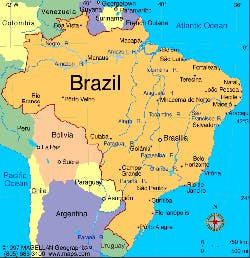Industry eying significant potential for Brazil’s aftermarket prospects
“The Brazilian market has great potential,” reports Linda Spencer, director of international and government relations for the Specialty Equipment Market Association (SEMA). “There’s so much promise – they love their cars.”
Although import tariffs ranging from 14 percent to 20 percent and a tough regulatory environment regarding vehicle add-ons have been lingering detours to a more robust pattern of aftermarket investment, SEMA has assisted its Brazilian counterparts this year in forming a new group called the Associacao Brasileira de Acessorios Automotivos, or ABAA.
(ABAA is translated as the Brazilian Association of Automotive Accessories. Take note that Portuguese, not Spanish, is the dominate language spoken in Brazil. Although similar to Spanish, there are key grammar and pronunciation differences that can make Spanish/Portuguese cross-speaking difficult.)
“The laws are currently not so pro-business and they are in a gray area,” continues Spencer, who has extensive experience in analyzing the South American nation’s automotive prospects. As ABAA’s 17 founding members get more in gear, SEMA will be providing model legislative proposals for perusal by governmental authorities.
“First come the products, and then – as in the U.S. – regulators look to manage the products,” Spencer explains to Aftermarket Business World. “When a government is new in dealing with our industry it might not be familiar with it.”
American standards promulgated over the years can be readily applied to Brazil’s regulatory climate. “We work with what has worked in the U.S., they don’t have to start from scratch,” she points out. For example, noise issues emitting from custom exhaust systems can be quieted by setting measurable decibel limits. Air-ride suspension and coil-over kits are currently not allowed; lawmakers can rise above these concerns by applying protocols that have already proven to be effective elsewhere. “The new association, ABAA, will work on these as well as allowing more performance upgrades,” says Spencer.
As the world’s fifth-largest population undergoes a consistent increase in its standard of living, some 9,000 new vehicles are being added to Brazil’s crowded roadways each day, creating a gridlock of horn-honking tie-ups.
“Traffic congestion is one of Brazil’s biggest problems because the country’s infrastructure has not kept pace with its rapid economic growth,” says Kush Parikh, senior vice president of business development at INRIX, a Kirkland, Wash.-based vendor of traffic information and location-based driver services that has recently formed a partnership with Brazil’s MapLink enterprise.
The agreement, reached in June, is especially timely as the nation gets ready to host soccer’s World Cup in 2014 and the Olympics in 2016.
“Sao Paulo, Rio and other major cities throughout Brazil have some of the worst traffic congestion in the world,” says Frederico Hohagen, MapLink’s founder and sales director. The navigational equipment transaction “will ensure we have the highest quality traffic information available to help industry and government address this taxing issue,” he adds.
It is anticipated that OEM- and aftermarket-based navigational device manufacturers will be forming additional partnerships “to meet the demands for low-cost navigation systems focused on the mass market segment,” according to Linda Wood, senior manager at Ireland’s Research and Markets publishing firm, which has produced several analyses of Brazil’s automotive sphere.
“Aftermarket systems will take leading steps by implementing the latest technologies, such as smartphone integration via MirrorLink and other standards into their offerings,” she notes.
“The major OEMs are expected to standardize their telematics services on all models,” says Wood, adding that a stolen vehicle tracking (SVT) mandate in Brazil is expected to make the region one of the largest global markets for telematics by 2014.
Cars, trucks and buses are all rolling off Brazilian assembly lines at an expanding pace as OEMs continue to increase investment dollars.
“Except in the Amazon Basin, buses are the primary form of long-distance transportation for the majority of Brazilians and many foreign travelers,” Wood reports. Bus production in the country is expected to post a 17 percent growth rate through 2015.
Light, medium and heavy trucks are the primary mode of freight transportation in Brazil, generally driven by independent owners who are not able to provide centralized large-volume services. “On the back of growing demand of goods in different regions of the country, the production of trucks has been growing continuously.” The output places Brazil “far ahead of its regional counterparts, including Argentina and Mexico,” she says.
“As per our analysis, luxury car sales are growing rapidly in the country with the rising per-head disposable income,” says Wood. Flex-fuel vehicles “are the most accepted segment, due to its multi-choice of refueling system,” she explains. “Owing to supportive government regulations on biofuel usage, the sales of flex-fuel vehicles have been registering blistering growth over the past few years.”
Ethanol has long been a fertile aspect of Brazil’s fuel infrastructure, a pattern that is being picked up by Epec Biofuels Holdings, Inc. for venturing into the U.S. marketplace. In June the firm received an infusion of investment dollars from InterCore Energy, Inc. of New Jersey.
Epec’s Ethanol 2.0 is identical to the first-generation American ethanol that has been produced from corn, yet it now “emulates the highly successful Brazilian industry model of production from sugarcane by using a hearty, sugar-rich sweet sorghum as the feedstock,” says Epec Executive Chairman Steve Vanechanos. “Further, instead of large central production facilities, the system plans to use factory-built modular production facilities that will be installed close to the feedstock, with the intention of bringing significant economic value to rural areas while preserving the overall ethanol production economics,” he adds. “The willingness of leading supply chain participants to become strategic partners within our integration platform is the next important milestone.”
Concurring with that vision for the U.S. alternative fuels market is InterCore CEO James F. Groelinger. “We believe strongly that the country needs to move forward in creative ways to develop significant domestic energy resources, especially those that avoid negative societal and environmental impacts,” he says. “The potential of sweet sorghum as an advanced biofuel feedstock is vast and largely untapped.”
Tapping into Brazil’s heightened attention toward sustainability issues, General Motors will encourage the use of public transportation and bicycles while also including a parking lot designated solely for flex-fuel vehicles as GM pioneers several environmental practices in constructing its new Joinville engine plant in the southern portion of the county.
The goal is compliance with Leadership in Energy and Environmental Design (LEED) standards presented by the U.S. Green Building Council. (If successful in securing LEED status, Joinville will join GM’s Lansing Delta Township assembly plant in Michigan and its Chinese headquarters in Shanghai in earning the distinction.)
Joinville’s sustainable initiatives include the first solar energy system in the Brazilian automotive industry. The facility will debut a water recycling process using reverse osmosis while employing a new way of treating sewage and wastewater via a wetland process. It will also be GM’s first landfill-free plant in the country.
Waste reduction will be obtained through use of local materials, certified wood and recycled content during construction, and solar energy will be harnessed to power the plant’s lighting on the manufacturing floor and in the administrative offices – an amount equal to the energy consumption of 285 Brazilian homes.
“We are one of the first companies in Brazil to push environmental innovation into the manufacturing space,” says Grace Lieblein, president of GM do Brasil. “Sustainability is in the DNA of our company, and we are incorporating environmental features into our facilities from the ground up.”
About the Author
James Guyette
James E. Guyette is a long-time contributing editor to Aftermarket Business World, ABRN and Motor Age magazines.

